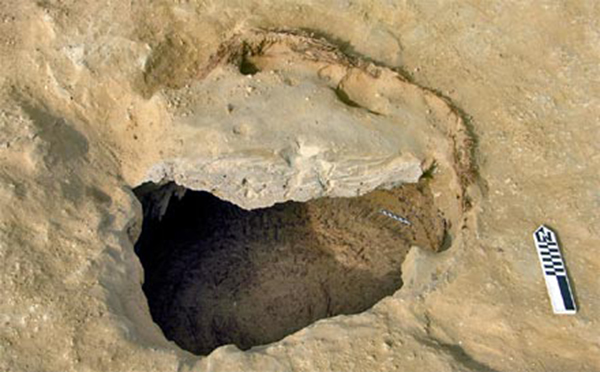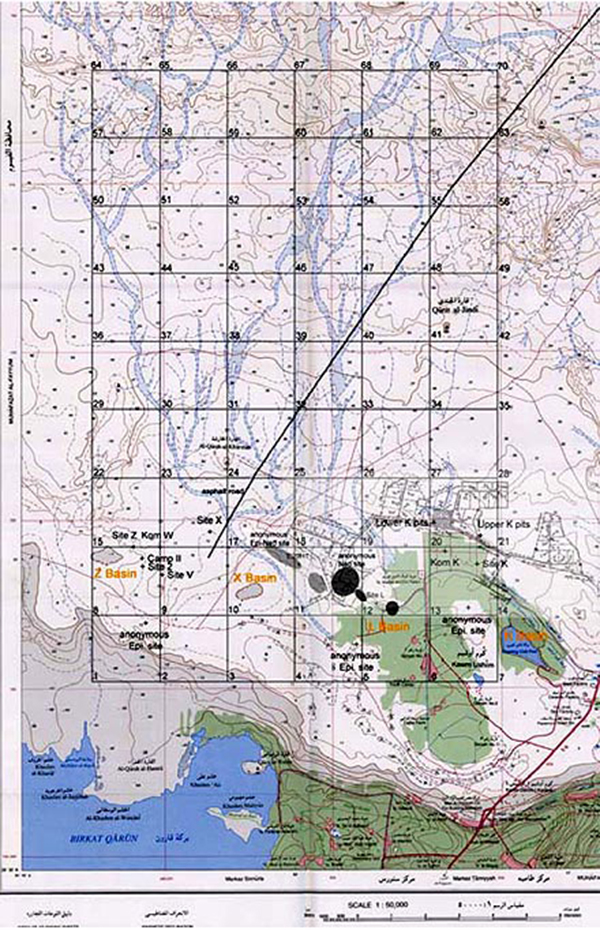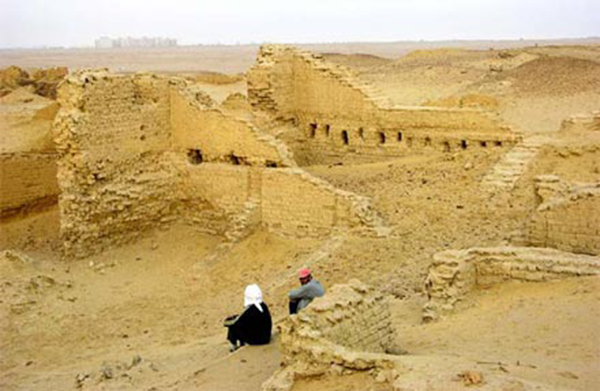
Season 2005
Upper K-pits
Work continued in the Upper K Pits. As outlined in the previous report, this area is of world importance. Excavation of pit 68, the best preserved Neolithic granary, was finished. Part of the Upper K Pits area is now protected by a fence. The land on which this granary was found, however, is not protected.

Neolithic granary pit 68 (Upper K Pits) lined with basketry and covered with a concrete lid
A decision had to be made regarding what to do with this important archaeological feature: a pit excavated in the soil, lined with an enormous basket and covered with a concrete lid, of which half is still in situ. It is the only example that has survived the ages, since the ones excavated in the 1920s were not left intact, but several of the baskets were lifted and are now in different museums in Great Britain. The condition of the present basket is partly very good, but half of it is in weak condition and it is inconceivable to lift the basket without destroying it. Taking off the lid is not possible either without destroying the basket, as its rim is imbedded in the concrete. Cutting out and strengthening the surrounding soil would be a major operation, without guarantee of success. The next question would be where and how to store an enormous block of at least 2 cubic meters.
Lake shore survey
The survey of the desert north of Lake Qarun in an area of 12 x 26 km confirmed that the Neolithic and Epi-paleolithic sites concentrate around the ancient lake shores. There are hardly any sites, or even stray finds, in the desert and along the wadis to the north.

X-Basin
A human skeleton found at the edge of X-Basin where the Wadi enters the basin, was embedded in a swamp layer. A trench was dug near the skeleton and showed that the swamp layer extended to a depth of approximately 1.50m and was overlaying a layer of diatomites, indicating a complete desiccation of an earlier lake.
With the exception of one skeleton, no prehistoric burials have been found in the Fayum. This skeleton, scattered over a large area, did not have any features of a burial either. Excavations here were finished in early December, when the trenches were backfilled completely. The team visited the site briefly on December 11, to find that someone with a backhoe had dug out an enormous trench of over two meters deep in the area where the shallow archaeological trench had been.
Kom K and Kom W
In preparation for the work in 2006, the project located two of the most famous Neolithic sites in the Fayum: Kom K and Kom W. Both have been excavated by Caton-Thompson in the 1920s, but excavation with modern techniques and research questions makes re-examination of these sites very important. Kom K has been part of an agricultural development project since the 1960s. The site has been plowed over, but a detailed study of the surface material will still provide important information. This study will be done in 2006. In Kom W the situation is different. This site seemed to be out of the danger area, it is part of the EEAA protected area along the north shore of Lake Qarun. However, we found that illegal hunters had settled on the site and dug a shelter into the Kom.
Site management in Karanis
This season saw the initial phase of a feasibility study for site management in Karanis (Kom Aushim). We photographed the standing walls of approximately 20 percent of the site. This documentation is vital for understanding the conservation needs and the deterioration of the mud brick. When the University of Michigan excavated the site between 1928 and 1934, they were engaged in a struggle to preserve the site from the sebakhin, who were exploiting the mud brick on an industrial scale. They found the houses in excellent condition, with many organic remains surviving the ages. Because they did not backfill the site, however, the buildings have suffered from rainfall and wind erosion.

Mudbrick architecture in Karanis. The holes in the wall most probably contained wooden bars that supported a second story.
At present a Virtual Reality model of Karanis is produced at UCLA, which will be used to study the site, and to illustrate the present preservation. A site management consultant spent 7 days in Karanis to make an assessment and propose a plan of action. Conservator Edward Johnson visited Karanis to give a first evaluation of the condition of the mud brick buildings and provide advice on how best to deal with the present situation. The architect Dr. Tarek Waly visited the site in early December and will start research.
Some of the recommendations are the development of clear routing and signing and a visitor's center where the history of the site and its importance in the agricultural economy of Ptolemaic and Roman Egypt will be explained. After restoration, the Michigan dig house might be suitable for this purpose. Furthermore, Secretary General of the Supreme Council of Antiquities Dr. Zahi Hawass, has initiated the founding of Fayum mummy portrait museum, to be established at Karanis.

